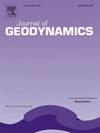Variations of the effective elastic thickness evidence for a wide diffusive boundary between the North American and Eurasian plates in Siberia
Abstract
Northeastern Eurasia is one of the least explored regions in the world. Very little geophysical data is available for this inaccessible area. Even the exact location of the plate boundary between Eurasia and North America remains a subject of ongoing debate. The effective elastic thickness (EET) of the lithosphere is a proxy for lithospheric strength and can provide insight into the thermal regime and tectonic processes. We have computed a high-resolution map of the EET for northeastern Eurasia using the fan wavelet coherence technique applied to the Bouguer gravity anomalies and topography/bathymetry data, appropriately adjusted to account for the influence of density variations within sediments. The results obtained provide insights into different tectonic regimes within this predominantly understudied region. In particular, we identify the boundary between the Eurasian and North American plates in Siberia as a rheologically weak diffusive zone extending from the Verkhoyansk and Sette-Daban Ranges to the eastern boundary of the Chersky Range. Unlike the Sette-Daban and Verkhoyansk Ranges, which were formed by plate collision and have an EET of 30–50 km, other mountainous regions have much lower EET values, usually less than 15 km. These areas have recently experienced tectonic activity that has weakened the lithosphere.

 求助内容:
求助内容: 应助结果提醒方式:
应助结果提醒方式:


